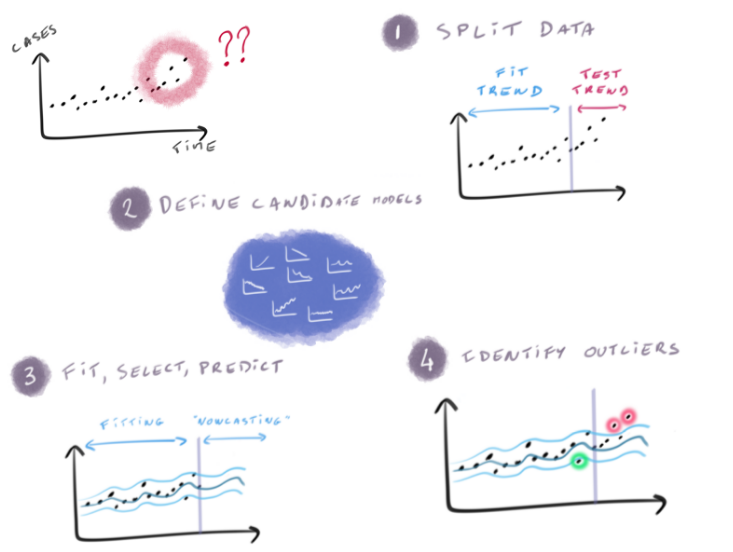Chapter 4 Implementing ASMODEE
ASMODEE is a new method for detecting recent changes in temporal trends
introduced by Jombart et al. (Jombart et al. 2021) and implemented in the R package
trendbreaker (Schumacher and Jombart 2021a) as the function asmodee. Rather than
attempting to estimate significant changes in growth rates or reproduction
numbers, which can usually only be done after changes have been taking place for
a week or two, ASMODEE tries to answer the question: “Are the last few days
matching what we would expect given the previous trend in the data?”.

Figure 4.1: Rationale of ASMODEE. This figure illustrates the key steps of ASMODEE for detecting recent changes in temporal trends.
To answer this question, ASMODEE implements the following approach (Figure 4.1):
Split the data in two sets: a testing set formed by the most ‘recent’ data (typically the last week), and a fitting set one used for charactering trends on the past few weeks (typically 6 - 10 weeks) prior to the testing set.
Define a range of candidate models to characterise temporal trends in the fitting set.
Extrapolate past trends to derive a 95% prediction interval (PI) for the last week of data.
Identify data outside the PI as outliers, suggesting either a slow-down (below the PI), or an acceleration (above the PI). In our algorithm for defining ELR for countries, we use a criteria of 3 net increases as a sign of acceleration; net increases are defined as the number of outliers above the PI, minus the number of outliers below the PI, in the last 7 days.
Step 2 is the crucial one to obtain good results. Defining the right set of candidate models to capture past trends is non-trivial, and is also the non-standard part of implementing ASMODEE, as model-generation is currently not implemented in trendbreaker, and requires ad-hoc code. In this chapter, we provide tips and explanations on how candidate models are generated, and can be adapted to other data streams.